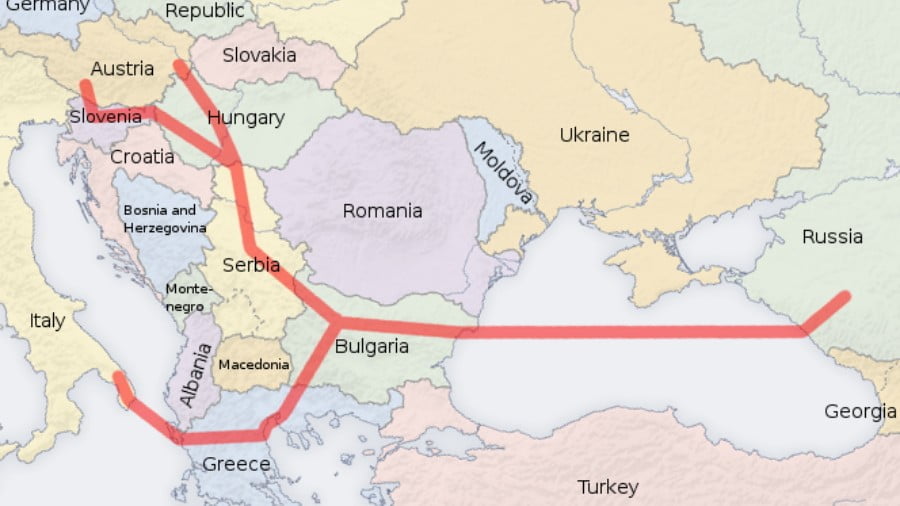Serbia Becomes Hub for Russia’s Gas Distribution in the Balkans
With the TurkStream gas pipeline now running through Serbia, the Balkan country will enjoy numerous benefits when exports begin, such as energy stability, the opportunity to get cheaper gas, and additional tax revenue. On December 25, Serbia successfully tested the TurkStream pipeline project that will connect Russian gas to consumers in Europe, especially in the Balkans. Serbian President Aleksandar Vučić revealed that the pipeline will be officially commissioned on December 30.
“The test run was successful. We did not publicize it too much but everything will start on December 30 as I promised. A small ceremony will be organized on that occasion because it is a huge deal for our country,” Vučić said.
The success of the test and Wednesday’s commissioning of the TurkStream brings an end to one of the most important projects in Serbian history. The gas pipeline strengthens the economic and geostrategic position of Serbia in the region as it can now become a hub to distribute Russian gas in the Balkans. The pipeline is 403 kilometers long and stretches from Zaječar on the border with Bulgaria to Horgoš on the border with Hungary.
There are numerous benefits that this gas pipeline will bring to Serbia, but the most important is energy stability. It is a two-way pipeline, meaning that gas can move between Bulgaria and Hungary in both directions. This is important because of energy security and, not only for Serbia, but for the entire Balkans network which can now be expanded.
The entire TurkStream pipeline within Serbian territory has not been built yet, but judging by the pace of the works so far, it will be completed without delay. Another compressor station remains to be completed in Serbia by June 2021.
The gas pressure on the TurkStream route is high enough that gas can pass from Bulgaria to Serbia. In fact, gas from Bulgaria can already be used in Pančevo, to the immediate east of Belgrade, for the needs of the gas power plant, such as generating electricity and heat. The extensive work for the gasification of Serbia, in full capacity, means that the TurkStream will allow Gazprom to export gas to the Republika Srpska, the Serbian-dominated entity that forms a part of Bosnia and Herzegovina, thus being able to deliver gas to the entirety of the country and perhaps even onwards to Croatia and Montenegro.
Five more gas power plants are planned to be constructed in Serbia in the near future. They will be built next to the largest industrial centers in Serbia. 4% of the total electricity produced in Serbia will come from Pančevo, in which thermal energy from the refinery and all its plants will be supplied. With the TurkStream at full capacity, it will be possible to build plants near Belgrade, Novi Sad, Niš and Kragujevac. When electricity is produced, thermal energy by-product will be used for large industrial plants, businesses and residential centers.
In addition to energy stability, Serbia will enjoy several other important benefits because of the passage of the TurkStream through its territory. Serbia will have minimum $40 cheaper gas per thousand cubic meters thanks to tax revenues that it will collect due to the transportation of gas through its territory to other countries. The Bulgarians negotiated with Gazprom a 27% lower price because imported gas from Ukraine passes through its territory to other countries. Serbia will be able to strike a similar deal so that Russian gas can reach Bosnia and Herzegovina, as well as Hungary, through its territory. It is also a benefit as servicing the gas pipeline and accompanying facilities has created job opportunities, and cheaper gas will inevitably lead to greater industrial output in other sectors.
The benefits of the TurkStream in Serbia will soon be realized as the most difficult part of the job was completed, laying pipes at the bottom of the Black Sea. It is for this reason that Russia prioritized finishing the TurkStream first, even though it has a much smaller capacity compared to Nord Stream 2. Nord Stream 2 has been continuously delayed due to Moscow’s anticipation that Washington would not only oppose the project, but pressure involved countries to withdraw and impose sanctions.
But with TurkStream to begin running in Serbia, it has not only consolidated Belgrade’s relations with Moscow, it gives hope to a country that was devastated by a decade-long NATO destruction in the 1990’s. Serbia has not been able to fully recover from the war, but cheap gas and job creation will transform the Balkan country, not only industrially, but also in terms of regional influence as it becomes a crucial energy hub for the entire region.







